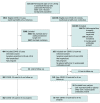Prevalence and Characteristics Associated With Post-COVID-19 Condition Among Nonhospitalized Adolescents and Young Adults
- PMID: 36995712
- PMCID: PMC10064252
- DOI: 10.1001/jamanetworkopen.2023.5763
Prevalence and Characteristics Associated With Post-COVID-19 Condition Among Nonhospitalized Adolescents and Young Adults
Abstract
Importance: The prevalence and baseline risk factors of post-COVID-19 condition (PCC) remain unresolved among the large number of young people who experienced mild COVID-19.
Objectives: To determine the point prevalence of PCC 6 months after the acute infection, to determine the risk of development of PCC adjusted for possible confounders, and to explore a broad range of potential risk factors.
Design, setting, and participants: This cohort study included nonhospitalized individuals from 2 counties in Norway between ages 12 and 25 years who underwent reverse transcription-polymerase chain reaction (RT-PCR) testing. At the early convalescent stage and at 6-month follow-up, participants underwent a clinical examination; pulmonary, cardiac, and cognitive functional testing; immunological and organ injury biomarker analyses; and completion of a questionnaire. Participants were classified according to the World Health Organization case definition of PCC at follow-up. Association analyses of 78 potential risk factors were performed.
Exposures: SARS-CoV-2 infection.
Main outcomes and measures: The point prevalence of PCC 6 months after RT-PCR testing in the SARS-CoV-2-positive and SARS-CoV-2-negative groups, and the risk difference with corresponding 95% CIs.
Results: A total of 404 individuals testing positive for SARS-CoV-2 and 105 individuals testing negative were enrolled (194 male [38.1%]; 102 non-European [20.0%] ethnicity). A total of 22 of the SARS-CoV-2-positive and 4 of the SARS-CoV-2-negative individuals were lost to follow-up, and 16 SARS-CoV-2-negative individuals were excluded due to SARS-CoV-2 infection in the observational period. Hence, 382 SARS-CoV-2-positive participants (mean [SD] age, 18.0 [3.7] years; 152 male [39.8%]) and 85 SARS-CoV-2-negative participants (mean [SD] age, 17.7 [3.2] years; 31 male [36.5%]) could be evaluated. The point prevalence of PCC at 6 months was 48.5% in the SARS-CoV-2-positive group and 47.1% in the control group (risk difference, 1.5%; 95% CI, -10.2% to 13.1%). SARS-CoV-2 positivity was not associated with the development of PCC (relative risk [RR], 1.06; 95% CI, 0.83 to 1.37; final multivariable model utilizing modified Poisson regression). The main risk factor for PCC was symptom severity at baseline (RR, 1.41; 95% CI, 1.27-1.56). Low physical activity (RR, 0.96; 95% CI, 0.92-1.00) and loneliness (RR, 1.01; 95% CI, 1.00-1.02) were also associated, while biological markers were not. Symptom severity correlated with personality traits.
Conclusions and relevance: The persistent symptoms and disability that characterize PCC are associated with factors other than SARS-CoV-2 infection, including psychosocial factors. This finding raises questions about the utility of the World Health Organization case definition and has implications for the planning of health care services as well as for further research on PCC.
Conflict of interest statement
Comment in
-
Post-COVID syndrome, the real matter of debate.J Med Virol. 2023 May;95(5):e28785. doi: 10.1002/jmv.28785. J Med Virol. 2023. PMID: 37212308 No abstract available.
References
Publication types
MeSH terms
Grants and funding
LinkOut - more resources
Full Text Sources
Medical
Miscellaneous


